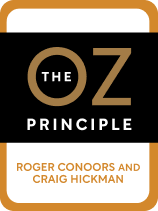

This article is an excerpt from the Shortform book guide to "The Oz Principle" by Roger Connors, Tom Smith, and Craig Hickman. Shortform has the world's best summaries and analyses of books you should be reading.
Like this article? Sign up for a free trial here .
How does accountability relate to The Oz Principle? What exactly do the authors mean by accountability?
The idea of accountability is at the heart of The Oz Principle‘s philosophy. The authors define accountability as the bridge or behavior that moves you from victimism and failure to success on both individual and organizational levels.
Here is why accountability (not skill, luck, and determination) is the key to success.
What Is the Oz Principle?
The authors use the story of The Wizard of Oz to teach people—from individuals seeking to improve their personal lives to company leaders trying to push their teams to new heights—how to get what they want. The lesson from The Wizard of Oz is:
- No one is going to give you the things you want or need. But you have the power to achieve them yourself—as long as you don’t get stuck in a victim mindset.
The Oz Principle lays out a journey from a mindset of victimism to one of accountability. The authors argue that the most common problems that plague companies—low productivity, slow innovation, and poor morale—can be solved. But there aren’t any tricks or shortcuts. Working through those problems requires people to take responsibility and hold themselves accountable, individually and then companywide.
(Shortform note: While many experts focus on skill, luck, and determination as the keys to success, accountability is often an underrated factor. However, accountability is arguably more important than these characteristics. In fact, the authors of The 4 Disciplines of Execution cite accountability as one of four essentials for successful execution (the others are focus, leverage, and engagement). Accountability in this formula takes the form of weekly sessions in which you review and account for your progress toward your goals.)
Lessons in Accountability From the Oz Story
The Wonderful Wizard of Oz by L. Frank Baum, published in 1900, is one of the quintessential “quest” texts in the literary canon, though most people probably know it from the 1939 movie starring Judy Garland. The authors use the story to illustrate their principles of accountability.
After a tornado transports Dorothy from Kansas to Oz, she travels the Yellow Brick Road with three companions in search of the Wizard, who they hope will help them. In The Oz Principle, the authors liken their steps to accountability to Dorothy’s journey.
- The Cowardly Lion hopes the Wizard can make him brave. In The Oz Principle, the Cowardly Lion represents the first step to accountability—facing facts—which requires the courage to face something you might prefer to avoid.
- The Tin Woodman wants the Wizard to grant him a heart. In The Oz Principle, the character represents the second step to accountability—admitting your role—because taking ownership of your circumstances (rather than blaming them on external forces) requires strength of character, or “heart.”
- The Scarecrow hopes the Wizard can give him a brain. He represents the third step to accountability—taking responsibility—which requires you to plan, problem-solve, and address the root of your problems.
- Dorothy represents the last accountability step—taking action—or following through on the solutions you come up with.
The companions learn that the Wizard is a fraud; there’s no simple, magical solution to their problems. But it turns out they didn’t need the Wizard—they each already had what they’d wished for. For instance, the Cowardly Lion frequently showed courage in the face of danger; he was already brave. And Dorothy needed only to click her heels together to activate the magic that would take her home.
| The Political Symbolism of The Wizard of Oz Viewing The Wizard of Oz as a tale about the journey from victimism to accountability isn’t the only, or even the most common, interpretation of this classic. Since its publication, both book and movie have inspired numerous allegorical interpretations. The most popular may be that Baum’s book is a political allegory for early 20th-century America. The plot apparently represents the bimetallism debate raging in the U.S. just before the book’s publication: In 1896, Democrats and Populists, represented by William Jennings Bryan, argued for a currency backed by both gold and silver, whereas the Republican Party and their leader, William McKinley, favored gold-only currency. Baum, a staunch Republican, is believed to have favored the gold standard. (McKinley won the presidential election, and the gold standard was used until FDR’s New Deal program in 1934.) The characters represent key players in the debate: Dorothy stands in for middle America (and its virtue), the “everyman” who’s been led astray. The Cowardly Lion represents Democrat William Jennings Bryan. The Tin Man represents industry. The Scarecrow represents agriculture and the challenges farmers faced in the late 19th century. The yellow brick road stands in for the gold standard, and Dorothy’s silver slippers, taken from the Wicked Witch of the East (they became ruby slippers in the film), represent the silver standard. “Oz” is thought to derive its name from the abbreviation for “ounces,” as in “ounces of gold and silver.” However, other analysts have used the same narrative details to come to almost completely opposite interpretations. |
Redefining Accountability
Most people have a negative—and incomplete—definition of accountability, one synonymous with fault. As a result, people resist the idea of being accountable because that’s like saying (as in victim-blaming) that you’re to blame for whatever goes wrong.
However, The Oz Principle defines accountability differently. Accountability means taking ownership of your circumstances by identifying how your actions contributed to them—and how your actions affect what happens to you next. Put another way, it’s taking responsibility and being proactive.
(Shortform note: In The 10X Rule, Grant Cardone argues that to be extraordinarily successful, you must take full responsibility for whatever happens in your life, even negative things like being in a car crash or having your identity stolen. Claiming responsibility for both the good and bad empowers you to act for better future outcomes. For instance, to reduce the future risk of a car accident, you could avoid peak traffic times or start a trip earlier so you don’t have to rush to your destination.)
The authors of The Oz Principle note that this philosophy is a more forward-thinking, constructive view of accountability than the typical reactive focus on fault. Owning failures allows you to act to not only avoid future problems, but also to create and own your future successes.
Accountability and Agency
The Oz Principle’s idea of accountability is similar to the sociological concept of agency. Sociologist Nicki Lisa Cole describes it as “the power people have to think for themselves and act in ways that shape their experiences and life trajectories.”
In The 12 Week Year, author and consultant Brian P. Moran similarly describes accountability as personal action. You hold yourself accountable when you make the choice to do what is needed. When you do something because you choose to do it rather than because you have to, you’re more empowered to perform the task to the best of your ability. Moran says that when you realize your choices create your path to success, you’ll see greater possibilities for your future and gain the courage to try new things to bring them to fruition.
Moving Toward Accountability
In contrast to passive and selfish behaviors, the authors say that the following accountability behaviors will push you across the bridge from victimism to success:
- Face facts
- Admit your role
- Take responsibility for solving the problem
- Take action
These behaviors comprise The Oz Principle’s four steps to accountability, which we’ll discuss in the next chapters. (Shortform note: In addition to these steps, other authors stress the need to make accountability a habit. However, this may require changing other habits—for example, to be accountable for consistently making it to work on time, you may need to wake up earlier and do fewer early morning chores, requiring you to do your chores in the evening and go to bed earlier. To help you form and stick with new habits, find an accountability partner.)

———End of Preview———
Like what you just read? Read the rest of the world's best book summary and analysis of Roger Connors, Tom Smith, and Craig Hickman's "The Oz Principle" at Shortform .
Here's what you'll find in our full The Oz Principle summary :
- Why you have more power to create change than you may realize
- How to stop thinking like a victim
- The four steps to mastering accountability






